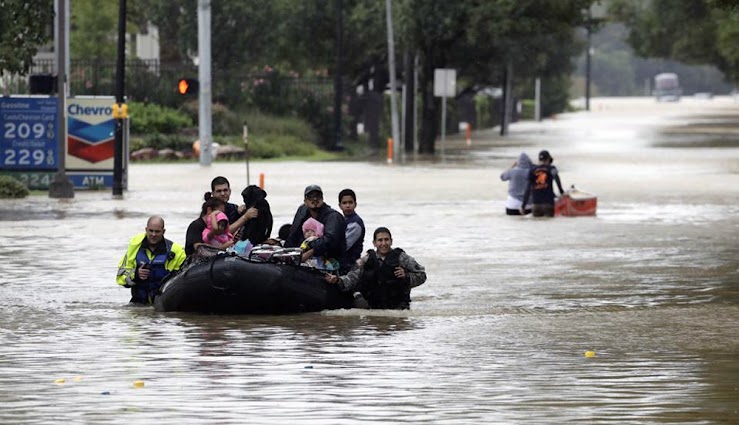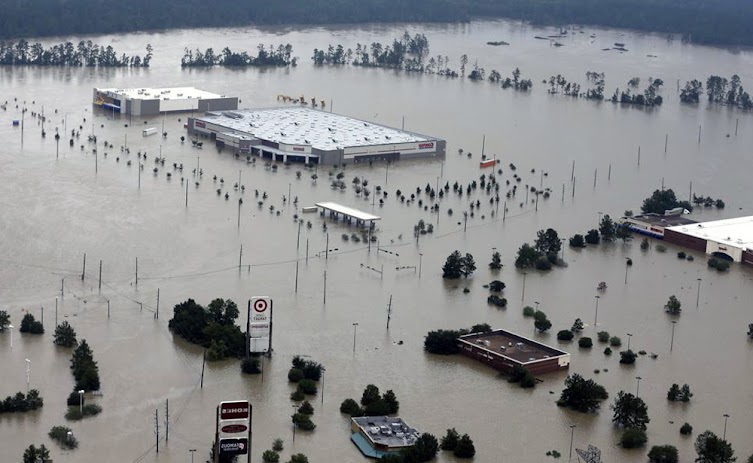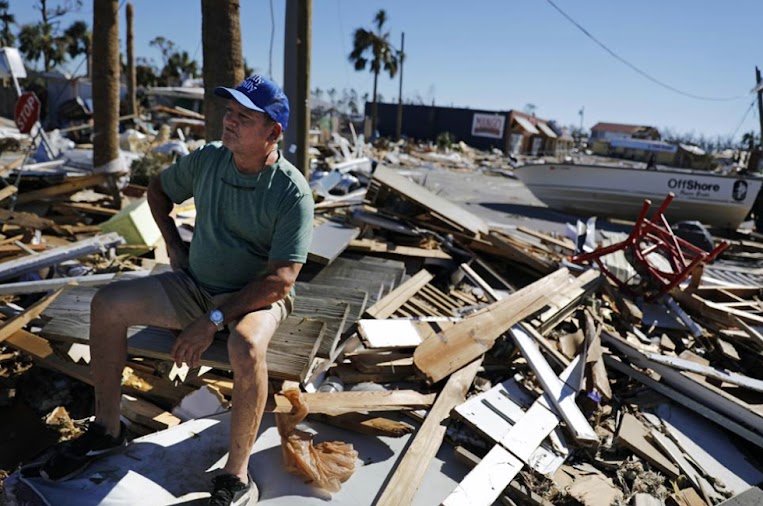 |
| FILE-In this Tuesday, Aug. 29, 2017 file picture, people leave a west Houston neighborhood swamped by floodwaters following a release from nearby Addicks Reservoir when it reached capacity due to Tropical Storm Harvey, in Houston, Texas. Extreme weather is becoming more prevalent, and this is just one of the warnings issued by the United Nations this week for the Gulf of Mexico region. (Charlie Riedel/AP Photo) |
In 2017, Hurricane Harvey poured more than 50 inches of rain along with areas of the Texas coast. Then, in 2020, Hurricane Laura's strong winds smashed houses along Louisiana's coast. Hurricane Ida struck New Orleans in 2021, knocking down electricity for several days.
Extreme weather is becoming more frequent, and this is just one of the warnings issued by the United Nations this week for the Gulf of Mexico region. Even if civilization manages to limit global warming to 1.5 degrees Celsius over pre-industrial levels, the region will be devastated by rising seas, falling fisheries, and toxic tides.
"There's a bigger possibility that the hurricanes that we get will bloom up into strong hurricanes," Louisiana's state meteorologist Barry Keim said, agreeing with the report's details on more dangerous weather.
The report dubbed a "map of human suffering," examines the myriad ways in which climate change will damage the Gulf of Mexico. The whole U.S. Gulf coast, from Texas to Florida, which has the longest coastline of any state, is under serious threat from rising waters as the planet's polar ice caps melt, according to a U.N. assessment.
The region, which includes major oil and gas production in Texas and Louisiana as well as tourist destinations in Mississippi, Alabama, and Florida, is politically conservative, and its mostly Republican leaders have prioritized climate change adaptation — higher roads, sea walls, and saltwater intrusion — over broad efforts to reduce greenhouse gas emissions or promote cleaner energy.
For example, the Republican-led Florida House of Representatives rejected to include clean-energy measures in a plan to protect the state against sea-level rise and floods on Tuesday. Demi Busatta Cabrera, a Republican from the Miami region, is the bill's sponsor, and she says her goal is to solve "what we can do now."
Democratic Rep. Ben Diamond, who is vying for a congressional seat in the St. Petersburg region, was upset that lawmakers did not do more.
Improved climate change resilience is important, but "there are also stopping the sources of those problems in terms of greenhouse gas emissions, in terms of cutting our carbon emissions," he said. The Florida House measure makes no mention of this.
People searching for 30-year mortgages are already shopping for residences and business structures that are less likely to flood. According to one report referenced by the United Nations, the trend is visible in Florida's Miami-Dade County, where some purchasers are avoiding pricey waterfront houses.
 |
| FILE-In this Tuesday, Aug. 29, 2017 file picture, businesses in Humble, Texas, are besieged by floodwaters from Tropical Storm Harvey. Extreme weather is becoming more prevalent, and this is just one of the warnings issued by the United Nations this week for the Gulf of Mexico region. (David J. Phillip, File/AP) |
Because so much of the Mississippi River delta has sunk as a result of human involvement, sea-level rise poses an existential threat to much of Louisiana. The loss of sediment from river leveeing and seawater intrusion induced by coastal oil and gas production are two major factors, according to Keim.
"South Louisiana is perhaps the most vulnerable place in the United States to climate change," Keim added.
The report warns that other sections of the Gulf face different concerns. The tourism and fishing sectors rely on healthy habitats off the shores of Florida and the Yucatan Peninsula, but coral reefs are bleaching as a result of "heated ocean waters interacting with non-climate stresses." According to the analysis, the deterioration of the reefs in Florida alone could result in $24 billion to $55 billion in economic losses by 2100.
The report goes into detail about the region's attempts to adapt to climate change. In 2021, Miami-Dade County issued a strategic sea level rise response plan that called for infrastructure adaptation, raising roadways, developing on higher ground, and expanding waterfront parks and canals.
The mayor of Miami Beach has already spent more than $500 million constructing pumps to flush water off the island, with no guarantees that the tourists' feet will remain dry. Miami is considering investing billions of dollars to keep the ocean at bay and reduce saltwater intrusion into freshwater supplies.
 |
| FILE-In this Friday, Oct. 12, 2018, file photo, Hector Morales rests on a debris pile near his home in Mexico Beach, Fla., which was wrecked by Hurricane Michael. Extreme weather is becoming more prevalent, and this is just one of the warnings issued by the United Nations this week for the Gulf of Mexico region. (Photo by AP/David Goldman, File) |
According to the United Nations report, Louisiana's Coastal Protection and Restoration Authority has a plan with "quite precise projects," such as dredging to replenish wetlands and repairing storm-damaged barrier islands.
Alex Kolker, an associate professor of coastal geology at the Louisiana Universities Marine Consortium in Cocodrie, pointed out that Louisiana also announced a strategy to reduce greenhouse gas emissions to zero by 2050 on Feb. 1.
Outbreaks of red tide, which are naturally harmful organisms first observed by Spanish explorers, have become more frequent and lethal as air and ocean temperatures have risen, according to experts.
The rising epidemics kill more fish and marine life while also harming the tourist business with stinky fish-strewn beaches, poor fishing, and the likelihood of harm to human health, particularly among persons with asthma or other respiratory disorders.
According to a University of Florida research, red tide cost the tourism industry $184 million in income from 2017 to 2019. Warmer water also promotes algal blooms, which are exacerbated by pollution from agricultural, urban, and other sources and are becoming more prevalent throughout Florida's coasts, contributing to the lack of seagrass, which has resulted in a record manatee die-off in the last year. Instead, the authorities fed romaine lettuce to one group of famished manatees.
"You can't just go out and plant a bunch of seagrass," Tom Reinert, regional director of the Florida Fish and Wildlife Conservation Commission, explained.
Anderson contributed reporting from St. Petersburg, Florida./ AP.









0 Comments
please do not enter any spam link in the comment box